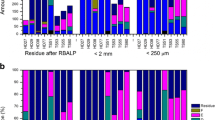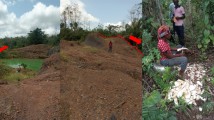Abstract
An urban survey of Lisbon, the largest city in Portugal, was carried out to investigate its environmental burden, emphasizing metallic elements and their public health impacts. This paper examines the geochemistry of lead (Pb) and its influence on human health data. A total of 51 soil samples were collected from urban recreational areas used by children to play outdoors. The semi-quantitative analysis of Pb was carried out by inductively coupled plasma mass spectrometry after an acid digestion. X-ray diffraction was used to characterize the soil mineralogy. The solid-phase distribution of Pb in the urban soils was investigated on a subset of 7 soils, out of a total of 51 samples, using a non-specific sequential extraction method coupled with chemometric analysis. Oral bioaccessibility measurements were obtained using the Unified BARGE Method developed by the Bioaccessibility Research Group of Europe. The objectives of the study are as follows: (1) investigation of Pb solid-phase distribution; (2) interpretation of Pb oral bioaccessibility measurements; (3) integration of metal geochemistry with human health data; and (4) understanding the influence of geochemistry and mineralogy on oral bioaccessibility. The results show that the bioaccessible fraction of Pb is lower when major metal fractions are associated with less soluble soil phases such as Fe oxyhydroxides, and more increased when the metal is in the highly soluble carbonate phase. However, there is some evidence that the proportion of carbonates in the soil environment is also a key control over the oral bioaccessibility of Pb, irrespective of its solid-phase fractionation.




Similar content being viewed by others
References
Caboche, J., Denys, S., Feidt, C., Delalain, P., Tack, K., & Rychen, G. (2010). Modelling Pb bioaccessibility in soils contaminated by mining and smelting activities. Journal of Environmental Science and Health Part A,. doi:10.1080/10934529.2010.493818.
Cachada, A., Pato, P., Rocha-Santos, T., Ferreira da Silva, E., & Duarte, A. C. (2012). Levels, sources and potential human health risks of organic pollutants in urban soils. Science of the Total Environment,. doi:10.1016/j.scitotenv.2012.04.075.
Cao, X., Wahbi, A., Mab, L., Li, B., & Yang, Y. (2009). Immobilization of Zn, Cu, and Pb in contaminated soils using phosphate rock and phosphoric acid. Journal of Hazardous Materials, 164(2–3), 555–564.
Cave, M. R., Milodowski, A. E., & Friel, E. N. (2004). Evaluation of a method for identification of host physico-chemical phases for trace metals and measurement of their solid-phase partitioning in soil samples by nitric acid extraction and chemometric mixture resolution. Geochemistry: Exploration Environment, Analysis, 4, 71–86.
Chiodo, L. M., Covington, C., Sokol, R. J., Hannigan, J. H., Jannise, J., Ager, J., et al. (2007). Blood lead levels and specific attention effects in young children. Neurotoxicology and Teratology,. doi:10.1016/j.ntt.2007.04.001.
Costa, C., Reis, A. P., Ferreira da Silva, E., Rocha, F., Patinha, C., Dias, A. C., et al. (2012). Assessing the control exert by soil mineralogy in the fixation of potentially harmful elements in the urban soils of Lisbon. Portugal: Environmental Earth Sciences. doi:10.1007/s12665-011-1362-8.
Cox, S. F., Chelliah, M. C. M., McKinley, J. M., Palmer, S., Ofterdinger, U., Young, M. E., et al. (2013). The importance of solid-phase distribution on the oral bioaccessibility of Ni and Cr in soils overlying Palaeogene basalt lavas. Northern Ireland: Environmental Geochemistry and Health. doi:10.1007/s10653-013-9539-6.
Denys, S., Caboche, J., Tack, K., & Delalain, P. (2007). Bioaccessibility of lead in high carbonate soils. Journal of Environmental Science and Health, Part A: Toxic/Hazardous Substances and Environmental Engineering. doi:10.1080/10934520701435569.
Denys, S., Caboche, J., Tack, K., Rychen, G., Wragg, J., Cave, M., et al. (2012). In Vivo validation of the unified BARGE method to assess the bioaccessibility of arsenic, antimony, cadmium, and lead in soils. Environmental Sciences and Technology,. doi:10.1021/es3006942.
Farmer, J. G., Broadway, A., Cave, M. R., Wragg, J., Fordyce, F. M., Graham, M. C., et al. (2011). A lead isotopic study of the human bioaccessibility of lead in urban soils from Glasgow, Scotland. Science of the Total Environment,. doi:10.1016/j.scitotenv.2011.08.061.
Filgueiras, A. V., Lavilla, I., & Bendicho, C. (2002). Chemical sequential extraction for metal partitioning in environmental solid samples. Journal of Environmental Monitoring,. doi:10.1039/b207574c.
Filippelli, G. M., & Laidlaw, M. A. S. (2010). The elephant in the playground: Confronting lead-contaminated soils as an important source of lead burdens to urban populations. Perspectives in Biology and Medicine, 53, 31–45.
Galhano, C., Rocha, F., & Gomes, C. (1999). Geostatistical analysis of the influence of textural, mineralogical and geochemical parameters on the geotechnical behavior of the “Argilas de Aveiro” formation (Portugal). Clay Mineralogy, 34, 109–116.
Gleyzes, C., Tellier, S., & Astruc, M. (2002). Fractionation studies of trace elements in contaminated soils and sediments: A review of sequential extraction procedures. Trends in Analytical Chemistry, 21(6 + 7), 451–467.
Johnson, D., & Bretsch, J. K. (2002). Soil lead and children’s blood lead levels in Syracuse, NY, USA. Environmental Geochemistry and Health, 24, 375–385.
Lanphear, B. P., Hornung, R., Khoury, J., Yolton, K., Baghurst, P., Bellinger, D. C., et al. (2005). Low-level environmental lead exposure and children’s intellectual function: an international pooled analysis. Environmental Health Perspectives,. doi:10.1289/ehp.7688.
Li, X., Poon, C., & Liu, P. S. (2001). Heavy metal contamination of urban soils and street dusts in Hong Kong. Applied Geochemistry, 16, 1361–1368.
Ljung, K., Oomen, A., Duits, M., Selinus, O., & Berglund, M. (2007). Bioaccessibility of metals in urban playground soils. Journal of Environmental Science and Health, Part A: Toxic/Hazardous Substances and Environmental Engineering. doi:10.1080/10934520701435684.
Morrison, D., Lin, Q., Wiehe, S., Liu, G., Rosenman, M., Fuller, T., et al. (2012). Spatial relationships between lead sources and children’s blood lead levels in the urban center of Indianapolis (USA). Environmental Geochemistry and Health,. doi:10.1007/s10653-012-9474-y.
Oliveira, A., Rocha, F., Rodrigues, A., Jouanneau, J., Dias, A., Weber, O., et al. (2002). Clay minerals from the sedimentary cover from the Northwest Iberian shelf. Progress in Oceanography, 52, 233–247.
Oomen, A. G., Rompelberg, C. J. M., Bruil, M. A., Dobbe, C. J. G., Pereboom, D. P. K. H., & Sips, A. J. A. M. (2003). Development of an in vitro digestion model for estimating the bioaccessibility of soil contaminants. Archives of Environmental Contamination and Toxicology,. doi:10.1007/s00244-002-1278-0.
Ottesen, R. T., Alexander, J., Langedal, M., Haugland, T., & Høygaard, E. (2008). Soil pollution in day-care centres and playgrounds in Norway: National action plan for mapping and remediation. Environmental Geochemistry and Health, 30, 623–637.
Palumbo-Roe, B., & Klinck, B. (2007). Bioaccessibility of arsenic in mine waste-contaminated soils: A case study from an abandoned arsenic mine in SW England (UK). Journal of Environmental Science and Health Part A,. doi:10.1080/10934520701435692.
Palumbo-Roe, B., Wragg, J., Cave, M. R., & Wagner, D. (2013). Effect of weathering product assemblages on Pb bioaccessibility in mine waste: Implications for risk management. Environmental Science and Pollution Research,. doi:10.1007/s11356-013-1515-2.
Park, J. H., Bolan, N., Megharaj, M., & Naidu, R. (2011). Comparative value of phosphate sources on the immobilization of lead, and leaching of lead and phosphorus in lead contaminated soils. Science of the Total Environment, 409, 853–860.
Pelfrêne, A., Waterlot, C., & Douay, F. (2013). Influence of land use on human bioaccessibility of metals in smelter-impacted soils. Environmental Pollution, 178, 80–88.
Reis, A. P., Patinha, C., Ferreira da Silva, E., & Sousa, A. J. (2012). Metal fractionation of cadmium, lead and arsenic of geogenic origin in topsoils from the Marrancos gold mineralisation, northern Portugal. Environmental Geochemistry and Health,. doi:10.1007/s10653-011-9433-z.
Reis, A. P., Patinha, C., Noack, Y., Robert, S., & Dias, A. C. (2013a). Assessing human exposure to aluminium, chromium and vanadium through ground-level dust ingestion in the Bassin Minier de Provence. France: Environmental Geochemistry and Health. doi:10.1007/s10653-013-9564-5.
Reis, A. P., Patinha, C., Noack, Y., Robert, S., Dias, A. C., & Ferreira da Silva, E., (2013a). Assessing the health risk of aluminium, zinc and lead in outdoor dusts collected in recreational sites used by children at an industrial area in the western part of the Bassin Minier de Provence, France. Journal of African Earth Sciences. doi:10.1016/j.jafrearsci.2013.08.001.
Reis, A. P., Patinha, C., Wragg, J., Dias, A. C., Cave, M., Sousa, A. J., et al. (2013c). Urban geochemistry of lead in gardens, playgrounds and schoolyards of Lisbon, Portugal: Assessing exposure and risk to human health. Applied Geochemistry,. doi:10.1016/j.apgeochem.2013.09.022.
Rodriguez, R. R., Basta, N. T., Casteel, S. W., & Pace, L. W. (1999). An in vitro gastrointestinal method to estimate bioavailable arsenic in contaminated soils and solid media. Environmental Sciences and Technology, 33, 642–649.
Ruby, M. V., Schoof, R., Brattin, W., Goldade, M., Post, G., Harnois, M., et al. (1999). Advances in evaluating the oral bioavailability of inorganics in soil for use in human health risk assessment. Environmental Sciences and Technology,. doi:10.1021/es990479z.
Salminen, R., Batista, M. J., Demetriades, A., Lis, J., & Tarvainen, T. (2005). Sampling. In R. Salminen (Ed.), Geochemical atlas of Europe. Part 1: Background information, methodology and maps. Espoo, Finland: Geological Survey of Finland.
Schultz, L. G. (1964). Quantitative interpretation of mineralogical composition from X-ray and chemical data for the Pierre Shale. U.S. geology survey professional papers. Washington, DC: U.S. Government Printing Office; 1964. 391-C:1–31.
Schumacher, B. A. (2002). Methods for the determination of total organic carbon (TOC) in soils and sediments. EPA/600/R-02/069 (NTIS PB2003-100822), U.S. Environmental Protection Agency, Washington, DC.
Thorez, J. (1976). Practical identification of clay minerals: A handbook for teachers and students in clay mineralogy. Dison: Lelotte.
U.S. Environmental Protection Agency (EPA) (1992). Ground water issue. behavior of metals in soils. Technology Innovation Office, Office of Solid Waste and Emergency Response, Washington, DC; EPA/540/S-92/018. http://www.epa.gov/superfund.
Wragg, J., & Cave, M. (2012). Assessment of a geochemical extraction procedure to determine the solid phase fractionation and bioaccessibility of potentially harmful elements in soils: A case study using the NIST 2710 reference soil. Analytica Chimica Acta,. doi:10.1016/j.aca.2012.02.008.
Wragg, J., Cave, M., Basta, N., Brandon, E., Casteel, S., Denys, S., et al. (2011). An inter-laboratory trial of the unified BARGE bioaccessibility method for arsenic, cadmium and lead in soil. Science of the Total Environment, 409, 4016–4030.
Wragg, J., Cave, M., & Nathanail, P. (2007). A study of the relationship between arsenic bioaccessibility and its solid-phase distribution in soils from Wellingborough, UK. Journal of Environmental Science and Health Part A. doi:10.1080/10934520701436062.
Acknowledgments
The authors acknowledge the Foundation for Science and the Technology (FCT) for supporting the Projects PTDC/CTE-GEX/68523/2006 and PEst-C/CTE/UI4035/2011. The authors also want to thank the reviewers for their helpful comments that significantly improved this paper.
Author information
Authors and Affiliations
Corresponding author
Rights and permissions
About this article
Cite this article
Reis, A.P., Patinha, C., Wragg, J. et al. Geochemistry, mineralogy, solid-phase fractionation and oral bioaccessibility of lead in urban soils of Lisbon. Environ Geochem Health 36, 867–881 (2014). https://doi.org/10.1007/s10653-014-9605-8
Received:
Accepted:
Published:
Issue Date:
DOI: https://doi.org/10.1007/s10653-014-9605-8




